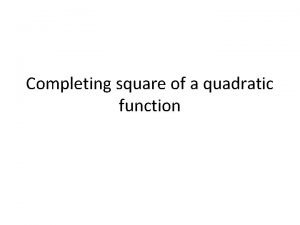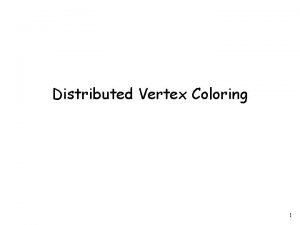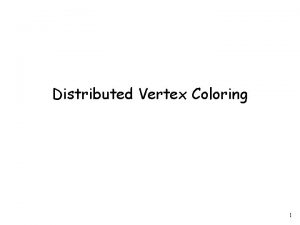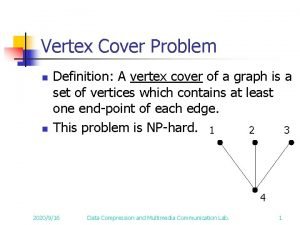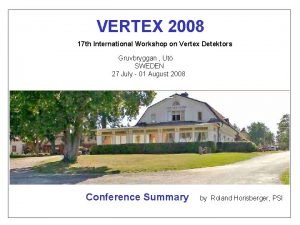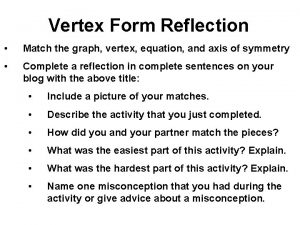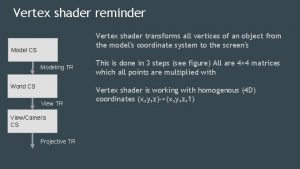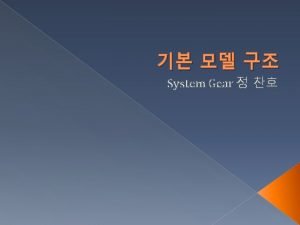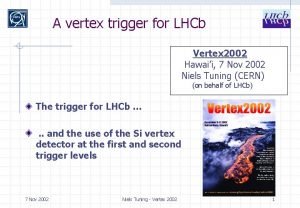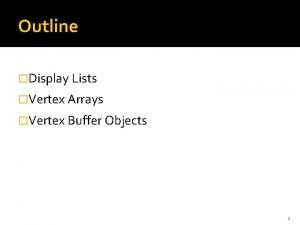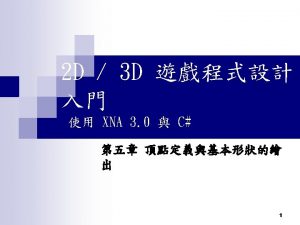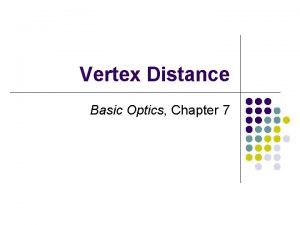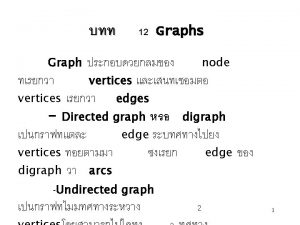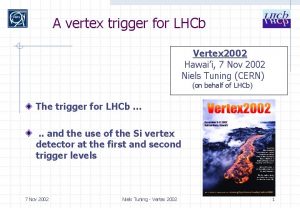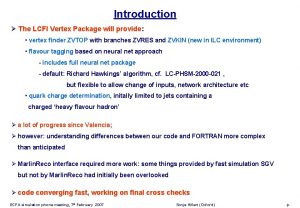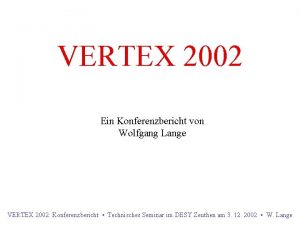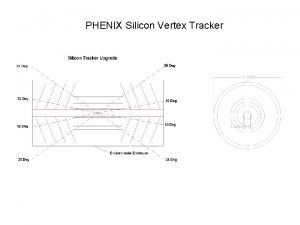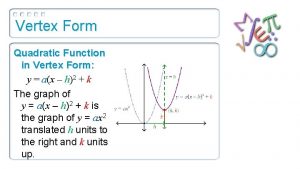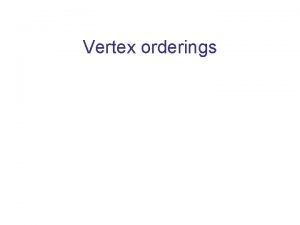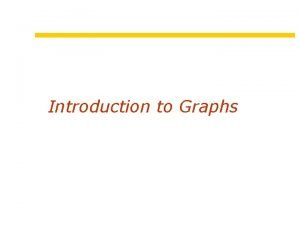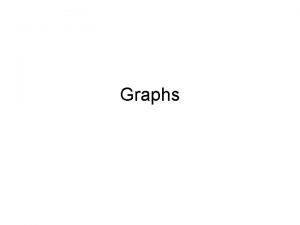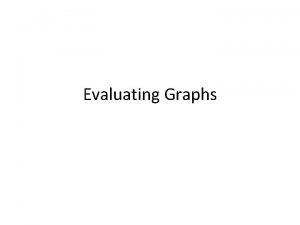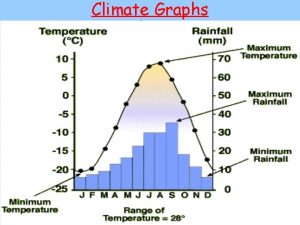Graphs G V E V is the vertex














































- Slides: 46

Graphs • • G = (V, E) V is the vertex set. Vertices are also called nodes and points. E is the edge set. Each edge connects two different vertices. Edges are also called arcs and lines. Directed edge has an orientation (u, v). u v

Graphs • Undirected edge has no orientation (u, v). u v • Undirected graph => no oriented edge. • Directed graph => every edge has an orientation.

Undirected Graph 2 3 8 1 10 4 5 6 9 7 11

Directed Graph (Digraph) 2 3 8 1 10 4 5 6 9 7 11

Applications—Communication Network 2 3 8 1 10 4 5 6 9 11 7 • Vertex = city, edge = communication link.

Driving Distance/Time Map 2 4 3 8 8 1 6 2 10 4 4 4 5 9 5 6 6 5 3 11 7 7 • Vertex = city, edge weight = driving distance/time.

Street Map 2 3 8 1 10 4 5 6 9 7 • Some streets are one way. 11

Complete Undirected Graph Has all possible edges. n=1 n=2 n=3 n=4

Number Of Edges—Undirected Graph • Each edge is of the form (u, v), u != v. • Number of such pairs in an n vertex graph is n(n-1). • Since edge (u, v) is the same as edge (v, u), the number of edges in a complete undirected graph is n(n-1)/2. • Number of edges in an undirected graph is <= n(n-1)/2.

Number Of Edges—Directed Graph • Each edge is of the form (u, v), u != v. • Number of such pairs in an n vertex graph is n(n-1). • Since edge (u, v) is not the same as edge (v, u), the number of edges in a complete directed graph is n(n-1). • Number of edges in a directed graph is <= n(n-1).

Vertex Degree 2 3 8 1 10 4 5 6 9 11 7 Number of edges incident to vertex. degree(2) = 2, degree(5) = 3, degree(3) = 1

Sum Of Vertex Degrees 8 10 9 11 Sum of degrees = 2 e (e is number of edges)

In-Degree Of A Vertex 2 3 8 1 10 4 5 6 9 11 7 in-degree is number of incoming edges indegree(2) = 1, indegree(8) = 0

Out-Degree Of A Vertex 2 3 8 1 10 4 5 6 9 11 7 out-degree is number of outbound edges outdegree(2) = 1, outdegree(8) = 2

Sum Of In- And Out-Degrees each edge contributes 1 to the in-degree of some vertex and 1 to the out-degree of some other vertex sum of in-degrees = sum of out-degrees = e, where e is the number of edges in the digraph

Graph Operations And Representation

Sample Graph Problems • Path problems. • Connectedness problems. • Spanning tree problems.

Path Finding Path between 1 and 8. 2 4 3 8 8 1 6 2 10 4 4 4 5 9 5 6 6 7 Path length is 20. 7 5 3 11

Another Path Between 1 and 8 2 4 3 8 8 1 6 2 10 4 4 4 5 9 5 6 6 Path length is 28. 7 7 5 3 11

Example Of No Path 2 3 8 1 10 4 5 6 No path between 2 and 9. 9 7 11

Connected Graph • Undirected graph. • There is a path between every pair of vertices.

Example Of Not Connected 2 3 8 1 10 4 5 6 9 7 11

Connected Graph Example 2 3 8 1 10 4 5 6 9 7 11

Connected Components 2 3 8 1 10 4 5 6 9 7 11

Connected Component • A maximal subgraph that is connected. § Cannot add vertices and edges from original graph and retain connectedness. • A connected graph has exactly 1 component.

Not A Component 2 3 8 1 10 4 5 6 9 7 11

Communication Network 2 3 8 1 10 4 5 6 9 11 7 Each edge is a link that can be constructed (i. e. , a feasible link).

Communication Network Problems • Is the network connected? § Can we communicate between every pair of cities? • Find the components. • Want to construct smallest number of feasible links so that resulting network is connected.

Cycles And Connectedness 2 3 8 1 10 4 5 6 9 11 7 Removal of an edge that is on a cycle does not affect connectedness.

Cycles And Connectedness 2 3 8 1 10 4 5 6 9 11 7 Connected subgraph with all vertices and minimum number of edges has no cycles.

Tree • Connected graph that has no cycles. • n vertex connected graph with n-1 edges.

Spanning Tree • Subgraph that includes all vertices of the original graph. • Subgraph is a tree. § If original graph has n vertices, the spanning tree has n vertices and n-1 edges.

Minimum Cost Spanning Tree 2 4 3 8 8 1 6 2 10 4 4 4 5 5 9 6 2 6 5 8 3 11 7 7 • Tree cost is sum of edge weights/costs.

A Spanning Tree 2 4 3 8 8 1 6 2 10 4 4 4 5 5 9 6 2 6 5 7 Spanning tree cost = 51. 7 8 3 11

Minimum Cost Spanning Tree 2 4 3 8 8 1 6 2 10 4 4 4 5 5 9 6 2 6 5 7 Spanning tree cost = 41. 7 8 3 11

A Wireless Broadcast Tree 2 4 3 8 8 1 6 2 10 4 4 4 5 5 9 6 2 6 5 8 7 7 Source = 1, weights = needed power. Cost = 4 + 8 + 5 + 6 + 7 + 8 + 3 = 41. 3 11

Graph Representation • Adjacency Matrix • Adjacency Lists § Linked Adjacency Lists § Array Adjacency Lists

Adjacency Matrix • 0/1 n x n matrix, where n = # of vertices • A(i, j) = 1 iff (i, j) is an edge 2 3 1 4 5 1 2 3 4 5 1 0 1 0 2 1 0 0 0 1 3 0 0 1 4 1 0 0 0 1 5 0 1 1 1 0

Adjacency Matrix Properties 2 3 1 4 5 1 2 3 4 5 1 0 1 0 2 1 0 0 0 1 3 0 0 1 4 1 0 0 0 1 5 0 1 1 1 0 • Diagonal entries are zero. • Adjacency matrix of an undirected graph is symmetric. §A(i, j) = A(j, i) for all i and j.

Adjacency Matrix (Digraph) 2 3 1 4 5 1 2 3 4 5 1 0 0 0 2 0 0 1 3 0 0 1 4 1 0 0 5 0 1 0 • Diagonal entries are zero. • Adjacency matrix of a digraph need not be symmetric.

Adjacency Matrix • n 2 bits of space • For an undirected graph, may store only lower or upper triangle (exclude diagonal). § (n-1)n/2 bits • O(n) time to find vertex degree and/or vertices adjacent to a given vertex.

Adjacency Lists • Adjacency list for vertex i is a linear list of vertices adjacent from vertex i. • An array of n adjacency lists. a. List[1] = (2, 4) 2 3 a. List[2] = (1, 5) a. List[3] = (5) 1 4 a. List[4] = (5, 1) 5 a. List[5] = (2, 4, 3)

Linked Adjacency Lists • Each adjacency list is a chain. 2 3 1 4 5 a. List[1] [2] [3] [4] a. List[5] 2 1 5 5 2 Array Length = n # of chain nodes = 2 e (undirected graph) # of chain nodes = e (digraph) 4 5 1 4 3

Array Adjacency Lists • Each adjacency list is an array list. 2 3 1 4 5 a. List[1] [2] [3] [4] a. List[5] 2 1 5 5 2 Array Length = n # of list elements = 2 e (undirected graph) # of list elements = e (digraph) 4 5 1 4 3

Weighted Graphs • Cost adjacency matrix. § C(i, j) = cost of edge (i, j) • Adjacency lists => each list element is a pair (adjacent vertex, edge weight)

Number Of C++ Classes Needed • Graph representations § Adjacency Matrix § Adjacency Lists ØLinked Adjacency Lists ØArray Adjacency Lists § 3 representations • Graph types § Directed and undirected. § Weighted and unweighted. § 2 x 2 = 4 graph types • 3 x 4 = 12 C++ classes
 Testability tips in software testing
Testability tips in software testing Graphs that compare distance and time are called
Graphs that compare distance and time are called Graphs that enlighten and graphs that deceive
Graphs that enlighten and graphs that deceive End behavior chart
End behavior chart Trời xanh đây là của chúng ta thể thơ
Trời xanh đây là của chúng ta thể thơ Sơ đồ cơ thể người
Sơ đồ cơ thể người Công thức tính độ biến thiên đông lượng
Công thức tính độ biến thiên đông lượng So nguyen to
So nguyen to đặc điểm cơ thể của người tối cổ
đặc điểm cơ thể của người tối cổ Tỉ lệ cơ thể trẻ em
Tỉ lệ cơ thể trẻ em Các châu lục và đại dương trên thế giới
Các châu lục và đại dương trên thế giới ưu thế lai là gì
ưu thế lai là gì Các môn thể thao bắt đầu bằng tiếng đua
Các môn thể thao bắt đầu bằng tiếng đua Tư thế ngồi viết
Tư thế ngồi viết Hát kết hợp bộ gõ cơ thể
Hát kết hợp bộ gõ cơ thể Cái miệng bé xinh thế chỉ nói điều hay thôi
Cái miệng bé xinh thế chỉ nói điều hay thôi Cách giải mật thư tọa độ
Cách giải mật thư tọa độ Từ ngữ thể hiện lòng nhân hậu
Từ ngữ thể hiện lòng nhân hậu Tư thế ngồi viết
Tư thế ngồi viết Thứ tự các dấu thăng giáng ở hóa biểu
Thứ tự các dấu thăng giáng ở hóa biểu Chó sói
Chó sói Thẻ vin
Thẻ vin Thể thơ truyền thống
Thể thơ truyền thống Khi nào hổ mẹ dạy hổ con săn mồi
Khi nào hổ mẹ dạy hổ con săn mồi Thế nào là hệ số cao nhất
Thế nào là hệ số cao nhất Diễn thế sinh thái là
Diễn thế sinh thái là Vẽ hình chiếu vuông góc của vật thể sau
Vẽ hình chiếu vuông góc của vật thể sau Slidetodoc
Slidetodoc Làm thế nào để 102-1=99
Làm thế nào để 102-1=99 Lời thề hippocrates
Lời thề hippocrates đại từ thay thế
đại từ thay thế Vẽ hình chiếu đứng bằng cạnh của vật thể
Vẽ hình chiếu đứng bằng cạnh của vật thể Glasgow thang điểm
Glasgow thang điểm Quá trình desamine hóa có thể tạo ra
Quá trình desamine hóa có thể tạo ra Thế nào là mạng điện lắp đặt kiểu nổi
Thế nào là mạng điện lắp đặt kiểu nổi Khi nào hổ con có thể sống độc lập
Khi nào hổ con có thể sống độc lập Các châu lục và đại dương trên thế giới
Các châu lục và đại dương trên thế giới Dot
Dot Thế nào là sự mỏi cơ
Thế nào là sự mỏi cơ Bổ thể
Bổ thể độ dài liên kết
độ dài liên kết Thiếu nhi thế giới liên hoan
Thiếu nhi thế giới liên hoan Bài hát chúa yêu trần thế alleluia
Bài hát chúa yêu trần thế alleluia điện thế nghỉ
điện thế nghỉ Vẽ hình chiếu vuông góc của vật thể sau
Vẽ hình chiếu vuông góc của vật thể sau Một số thể thơ truyền thống
Một số thể thơ truyền thống Complete the square calculator vertex form
Complete the square calculator vertex form














































